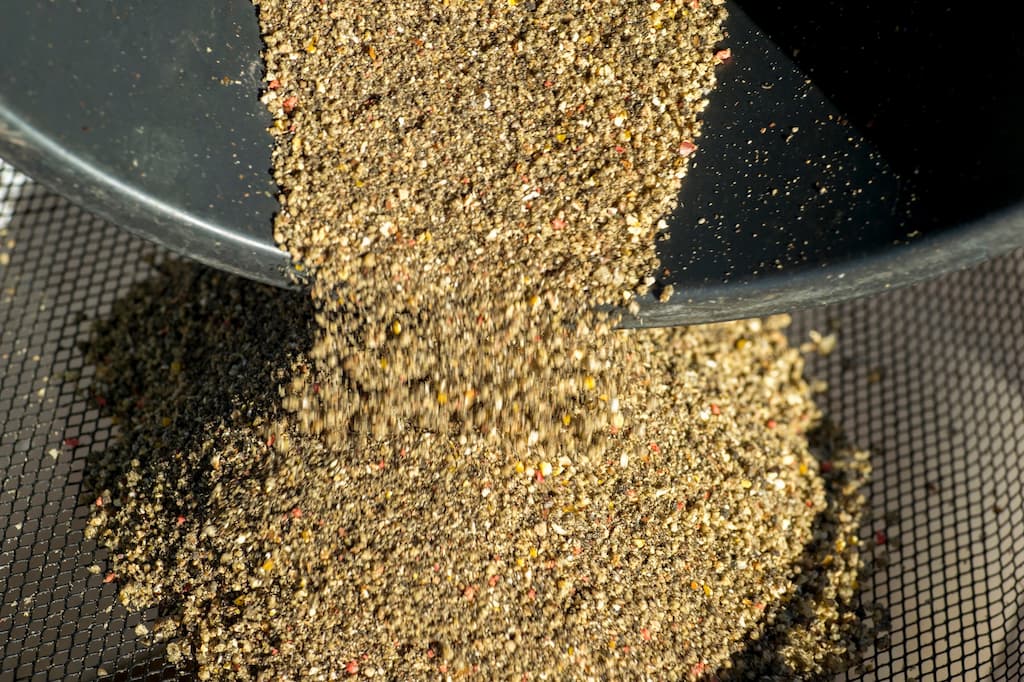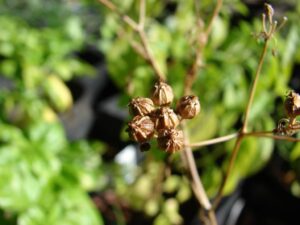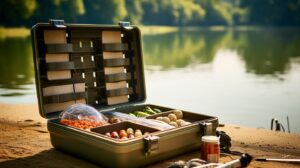Baits and groundbaits make the difference

When it comes to freshwater fishing, choosing the correct bait can significantly impact your success on the water. Baits and ground baits are essential tools used to attract fish and increase their chances of landing a catch.
We will explore the world of baits and ground baits, understanding their purpose and differences and how to use them effectively in freshwater fishing.

What is a Bait?
A bait refers to any substance or object used to attract fish and entice them to bite the hook. Appeals can be natural or artificial, with each type having advantages and disadvantages. Natural baits include live or dead organisms like worms, minnows, and insects, while artificial lures are manufactured to resemble the appearance and movement of wild prey.
The purpose of bait is to mimic the natural food sources of fish and trigger their predatory instincts. By presenting an enticing lure, anglers can increase their chances of attracting fish and enticing them to strike.
What is Groundbait?
Ground bait, on the other hand, is a specific type of bait used to attract fish to a particular fishing spot. It is typically a mixture of ingredients, such as breadcrumbs, crushed pellets, oils, and other additives, combined to create an intense aroma and flavour concoction.
Unlike traditional bait, ground bait is not attached to the hook directly. Instead, it is scattered or introduced into the water to create a feeding area. As fish consume the ground bait, they become more active and are more likely to bite the bait hook.
Difference between Bait and Groundbait
The main difference between bait and ground bait is their application and purpose. While both are used to attract fish, they serve different functions in freshwater fishing.
Bait, as mentioned earlier, refers to the actual substance or object attached to the hook to lure fish. It can be either natural or artificial and is designed to mimic the appearance and movement of wild prey. Anglers use bait to entice fish to bite the hook, relying on their predatory instincts.
Ground bait, on the other hand, is not directly attached to the hook but instead used to create a feeding area in the water. It is a mixture of various ingredients scattered or introduced into the fishing spot. Ground bait aims to attract fish to a specific site by creating a concentration of food particles and enticing them to feed. While bait targets individual fish, ground bait seeks to draw more fish to a particular location.
Types of Baits
When it comes to baits, there is a wide variety available for freshwater fishing. Anglers can choose from natural baits, such as worms, minnows, insects, and small fish, or artificial baits, such as soft plastic lures, crankbaits, or spinners. Each bait type has its advantages and is suitable for different fishing conditions and target species.
Natural baits are highly effective as they closely resemble the food sources that fish naturally prey upon. They emit scent and movement that can entice fish to strike. On the other hand, artificial baits offer versatility in colours, shapes, and actions. They can be designed to mimic specific prey and are often preferred for their durability and ease of use.
Anglers need to understand the preferences of the fish they are targeting and choose baits that best match their natural diet and behaviour. Experimenting with different tricks and observing the response of the fish can help determine the most effective choice in a particular fishing situation.
Types of Ground baits
Ground baits also come in various forms, and the choice depends on the specific fishing scenario and target species. Standard ground baits include breadcrumb mixtures, crushed pellets, ground-up boilies, and particle blends.
Breadcrumb mixtures are famous for creating a cloud effect in the water. They disperse quickly and can attract fish from a distance. Crushed pellets, conversely, provide a concentrated source of scent and flavour, drawing fish to the immediate area.
Ground-up boilies are commonly used for carp fishing. These specialised baits are made from various ingredients and offer a lovely scent and taste. Particle blends like hempseed and corn can be effective for multiple species like Roach, Bream, and Tench.
Anglers can also customise their ground baits by adding additional attractants like oils, flavours, or additives to enhance their effectiveness. The choice of ground bait depends on the target species, fishing conditions, and personal preferences.
Choosing the Right Bait
Selecting the right bait is crucial for a successful fishing trip. Considerations such as the target species, fishing location, weather conditions, and time of year all play a role in determining the most effective bait.
When choosing bait, it is essential to research the feeding habits and preferences of the fish species you intend to catch. Different fish have distinct feeding patterns, and understanding their preferences can significantly increase your chances of success.
Factors like water temperature, clarity, and current should also be considered when selecting bait. Some fish species are more active in warmer water, while others prefer cooler temperatures. Similarly, fish that inhabit clear water may be more selective in their feeding habits than those in murky or stained water.
Observation and research are vital in determining the best bait for a specific fishing situation. Talk to local anglers or consult fishing guides to gain insights into successful bait choices in your area. Experimentation is also essential, as fish behaviour can vary daily. By trying different baits and noting the response of the fish, you can refine your bait selection over time.
I think it’s worth mentioning that having a variety of bait options in your tackle box is advantageous. Fish can exhibit changing preferences throughout the day, and having multiple bait choices allows you to adapt to their feeding patterns. As you gain experience, you will understand which baits work best in different conditions, increasing your overall success rate.
Using Baits in Freshwater Fishing
Once you have selected the appropriate bait, you must attract fish effectively. Presenting the appeal can make a significant difference in enticing fish to bite. Here are some tips for using tricks in freshwater fishing:
- Hook Placement: Ensure that the hook is securely embedded in the bait to prevent it from easily detaching. The hook should be concealed within the bait to appear natural to the fish.
- Casting Technique: Cast your baited hook near areas where fish are likely to be present, such as underwater structures, submerged vegetation, or areas with current breaks. Pay attention to depth variations and fish behavior to determine the best casting spots.
- Retrieve Techniques: Experiment with different retrieve techniques based on the type of bait you are using. This could include slow and steady retrieves, erratic movements, or pausing intermittently to mimic injured prey. Observe the response of the fish and adjust your retrieve accordingly.
- Depth Control: Use appropriate weights or floats to control the depth at which your bait is presented. Fish may be positioned at different levels in the water column, and adjusting the depth can increase your chances of attracting them.
- Patience and Observation: Fishing with baits requires patience and keen observation. Pay attention to any signs of fish activity, such as surface disturbances, feeding activity, or fish jumping. Adapt your strategy based on the observed behavior of the fish.
By employing these techniques and adapting to the specific conditions of your fishing location, you can effectively use baits to attract and catch freshwater fish.
Using Groundbaits in Freshwater Fishing
Groundbaits can be a valuable addition to your fishing arsenal, mainly targeting species attracted to feeding areas. Here are some tips for using ground baits in freshwater fishing:
- Location Selection: Choose your fishing spot strategically, considering factors such as underwater structures, vegetation, and fish activity. Please look for areas where fish are likely to gather and feed since this is where you would like to introduce your ground bait.
- Proper Mixing: Follow the instructions provided with the ground bait or experiment with different ratios to achieve the desired consistency. The mixture should be moist enough to bind together but not overly wet. Proper mixing ensures that the ground bait disperses effectively in the water.
- Application Technique: Scatter or introduce the ground bait into the water near your fishing spot. Use a feeder or a method feeder to deliver the ground bait accurately to the desired location. Pay attention to the wind and current direction to ensure the ground bait spreads evenly.
- Timing and Frequency: Introduce the ground bait before or during your fishing session to create a feeding area and attract fish. The timing may vary depending on the specific fishing conditions and the behaviour of the target species. It is recommended to introduce ground bait in smaller amounts initially and gauge the fish’s response. You can gradually increase the frequency and quantity of ground bait if it is effective.
- Mixing Variations: Experiment with different variations of ground bait mixtures to cater to the preferences of your target fish species. Some fish may be attracted to sweet or fruity aromas, while others may respond better to savoury or fishmeal-based blends. Customising your ground bait can increase its effectiveness in attracting the desired fish.
- Monitoring and Adjustments: Observe the fish’s response to the ground bait. It indicates success if you notice increased fish activity, bites, or feeding frenzy near your ground bait. If there is little to no response, consider adjusting the composition or introducing a different ground bait altogether.
- Complementary Baits: Consider using a combination of ground bait and baited hooks to maximise your chances of catching fish. The ground bait attracts fish, while the baited hooks allow fish to bite. You can experiment with different bait options to find the most effective combination.
Ground baits can significantly enhance your fishing experience by concentrating fish in a specific area and increasing their feeding activity. It is essential to be patient, observe fish behaviour, and adapt your ground bait strategy accordingly.
Tips for Effective Baiting
To make the most of your baiting efforts and increase your chances of success, consider the following tips:
- Research and Local Knowledge: Gain insights into the feeding habits, preferences, and behaviour of the target fish species in your area. Local anglers, fishing forums, and guides can provide valuable information to help you choose the right ground bait.
- Quality and Freshness: Ensure that your baits are fresh, in good condition, and of high quality. New baits emit more scent and are more enticing to fish. Replace any damaged or spoiled tricks to maintain their effectiveness.
- Storage and Preservation: Properly store your baits to preserve their freshness and scent. Keep live baits in a suitable container with adequate aeration and water temperature. For artificial baits, organize them in tackle boxes to prevent damage and maintain their appearance.
- Match the Hatch: Observe the natural food sources available to the fish in the area you are fishing. Try to mimic those food sources by selecting baits that closely resemble them in size, shape, and color. Matching the hatch increases the chances of attracting fish.
- Experimentation: Be open to trying new baits, techniques, and presentations. Fishing can be dynamic, and fish behavior can change. By experimenting with different baits and approaches, you can adapt to the ever-changing conditions and increase your success rate.
Remember, fishing is not an exact science, and success can vary depending on multiple factors. It is essential to stay adaptable, patient, and persistent in your baiting efforts.
Common Mistakes to Avoid
While baiting is an effective technique, certain common mistakes can hamper your fishing success. Avoid the following errors to maximize your chances of landing a catch:
- Overfeeding: Using excessive amounts of groundbait or bait can overwhelm the fish and make them wary. Start with smaller quantities and gradually increase if needed.
- Ignoring Environmental Factors: Failure to consider factors such as water temperature, weather conditions, and the natural behavior of fish can impact the effectiveness of your baiting. Adapt your baiting strategy to suit the prevailing conditions.
- Lack of Observation: Fishing requires careful observation. Pay attention to any signs of fish activity, changes in water conditions, or the response to your bait. Adjust your approach based on these observations.
- Using Stale or Ineffective Bait: Ensure that your baits are fresh, appealing, and suitable for the target species. Using stale or ineffective bait will significantly reduce your chances of attracting fish.
- Improper Hook Placement: Properly secure the bait on the hook to prevent it from easily detaching. Incorrect hook placement can result in missed opportunities or lost fish.
- Poor Presentation: The way you present your bait can make a significant difference. Ensure that the bait appears natural and enticing to the fish. Avoid excessive movements or unnatural actions that may deter fish.
- Lack of Patience: Fishing requires patience and persistence. It may take time for fish to discover and respond to your bait. Avoid the temptation to constantly change bait or location prematurely.
By avoiding these common mistakes and following the tips provided, you can improve your baiting techniques and increase your chances of success in freshwater fishing.




